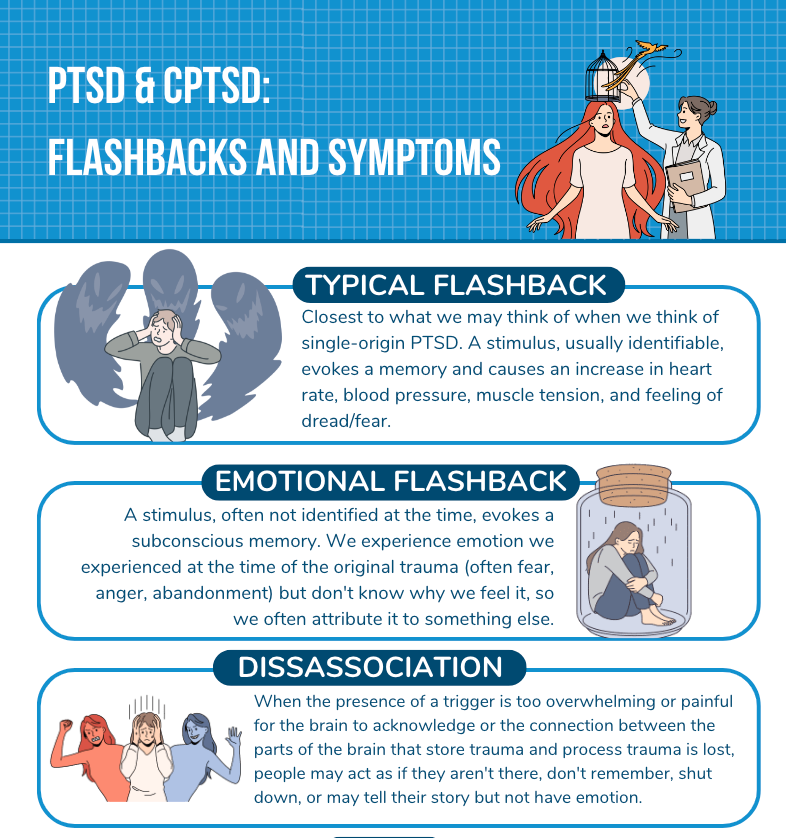Complex Trauma/CPTSD:
Complex Post-Traumatic Stress Disorder (CPTSD) is similar to PTSD. Its defining difference is that CPTSD occurs after multiple instances of trauma, often involving relationships (with our families, romantic partners, or in the school system or other institution). Instead of a singular trauma and limited, easily identifiable triggers and responses, people with CPTSD experience a wide range of triggers and emotional and physical responses. It is common for CPTSD to affect many different areas of a person’s life. It’s also common for the trauma that causes CPTSD to be perceived as “subtle” or unseen, even by the person experiencing it. While surviving a car crash (single origin PTSD) is an obvious threat to one’s life, the traumas that happen in relationships are often explained away by ourselves or others (we are told our caretakers loved us or did the best they could, a romantic partner gaslights us into believing fights are our fault).

Flashbacks can be considered a form of disassociation. When we experience a flashback, knowingly or not, the brain disconnects with the current environment or scenario. It ‘disassociates’ with reality. Disassociation can also look like shutting down, forgetting memories, or acknowledging trauma but with flat affect, or any number of responses.
A typical flashback involves challenges in regulating and returning to a baseline state. For instance, an unexpected loud noise may trigger a startle response for most people. While most people quickly recover, for someone experiencing a PTSD or CPTSD flashback, the normalization of physiological responses, such as heart rate and breathing, or a feeling of being on edge and high alert may take several hours, highlighting difficulties in promptly regulating emotional and physiological states.
Emotional flashbacks are different. Our bodies become triggered, often subconsciously, by a reminder of our past trauma. We often don’t even know this is happening. We may feel out of control, highly emotional, angry, fearful, anxious, or panicked. Even if we identify that we are experiencing an emotional flashback, it’s common to have no clue why. We may know we are upset but attribute it to a present situation or a conflict with someone going on in the here and now. Emotional flashbacks are often “silent”. We may not “hear” or “see” them, and others that care about us may have no clue that anything is going on with us either.
CPSD in Relationships:
CPTSD often gets the ugliest in our closest relationships. Single origin PTSD is triggered by things (nature, accidents, war), while CPTSD is triggered by relationships. Even if it’s difficult to do so, we can avoid riding in a car or attending a fireworks show. Those triggers also have clearly defined time parameters. They are, at some point, over, and we recover. We can’t avoid relationships, and the triggers in a relationship (power, attachment, feeling misunderstood, uncared for or unseen) are ongoing. Without help and practice, we aren’t able to easily identify, let alone avoid or manage our triggers. It’s very hard for our partners to identify and help us manage them as well.
Miscommunication becomes a significant challenge in relationships affected by CPTSD. A tone of voice, a specific word, a physical trait, or a situation, can evoke profound feelings of shame, guilt, and fear. The complexity of relationships amplifies the impact of these triggers. ‘Safe’ people may inadvertently resemble those who caused past harm. Again, we often don’t know, on a conscious level, this happens. We just know we feel something or a certain way, and that we feel it intensely. This often leads us blaming our partners, or in their viewpoint, blowing things out of proportion. Arguments blow up, and our triggers are further activated.
CPTSD in the workplace:
Our traumas are often triggered in the workplace when certain situations or dynamics resemble or echo past traumatic experiences. If we experienced abuse in the home, we may be triggered by supervisors or leaders who display similar traits. Authoritarian management styles, criticism, or harsh feedback can evoke memories of past trauma. Just the existence of a power imbalance in the workplace can evoke feelings of being powerless or voiceless and reawaken past trauma.
Those of us with CPTSD often have difficulty drawing boundaries at work. We may have managed the chaos in our own homes by doing our best to stay out of trouble or found a sense of purpose and praise in being competent. Taking care of our own needs may have been our best or only coping mechanism. It may not have been safe to ask for help or to say no. Drawing boundaries at work can trigger a fear of conflict, disapproval, powerlessness, and fear. Difficulty with boundaries may look like people pleasing, difficulty maintaining a healthy work-life balance, physical and mental anxiety and stress, and a feeling of panic and fear associated with workplace dynamics.
How do we heal?
Trauma happens when we aren’t in control. It heals when we are. The healing journey often begins when we start to take control over our narrative. The act of telling and retelling our stories in a safe environment becomes a way to reshape our relationship with our past and gain a deeper understanding of what happened to us. It allows us to take ownership of our lives and our history. Many times, we see a significant improvement in the amount of distress someone feels after the first counseling session, simply because they have had the space to begin to tell and rewrite their story.
Educating ourselves about CPTSD is also an essential step in this healing journey. Understanding the intricacies of this complex condition, from its origins to its manifestations in relationships, provides a foundation for informed self-care. When we understand what is going on in our brains and bodies, the fear and distress associated with our symptoms often lessens.
Additionally, recognizing triggers and cognitive distortions that trauma creates empowers us to navigate flashbacks and other symptoms of CPTSD. The more we can identify what is happening, the more we can plan out what to do when we are experiencing it as well as plan for a smoother recovery period.
If you or someone you care about may be experiencing CPTSD, our counselors are here to help.

